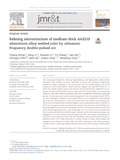JavaScript is disabled for your browser. Some features of this site may not work without it.
| dc.contributor.author | Wang, Yipeng | |
| dc.contributor.author | Li, Hong | |
| dc.contributor.author | Li, Zhuoxin | |
| dc.contributor.author | Zhang, Yu | |
| dc.contributor.author | Qin, Jian | |
| dc.contributor.author | Chen, Guangyu | |
| dc.contributor.author | Qi, Bojin | |
| dc.contributor.author | Zeng, Caiyou | |
| dc.contributor.author | Cong, Baoqiang | |
| dc.date.accessioned | 2023-02-20T10:32:08Z | |
| dc.date.available | 2023-02-20T10:32:08Z | |
| dc.date.issued | 2023-02-14 | |
| dc.identifier.citation | Wang Y, Li H, Li Z, et al., (2023) Refining microstructure of medium-thick AA2219 aluminium alloy welded joint by ultrasonic frequency double-pulsed arc. Journal of Materials Research and Technology, Volume 23, March-April 2023, pp. 3048-3061 | en_UK |
| dc.identifier.issn | 2238-7854 | |
| dc.identifier.uri | https://doi.org/10.1016/j.jmrt.2023.01.174 | |
| dc.identifier.uri | https://dspace.lib.cranfield.ac.uk/handle/1826/19213 | |
| dc.description.abstract | The increasing demand for achieving high-efficiency and high-quality medium-thick aluminium alloy welded structures, especially for large scale aerospace components, presents an urgent challenge to the conventional TIG arc welding process. This work proposed a novel double-pulsed variable polarity tungsten inert gas (DP-VPTIG) arc, in which the variable polarity square wave current was simultaneously modulated into ultrasonic frequency (20–80 kHz) and low frequency (0.5–10 Hz) pulses. Full penetration welds of 6 mm thick AA2219 aluminum alloy were successfully obtained by using this process. The microstructure and mechanical properties of the weld produced by DP-VPTIG arc were investigated, taking the conventional VPTIG arc as a comparative study. Results show that the microstructure of weld zone by DP-VPTIG arc showed an alternating distribution of fine equiaxed grain band and slightly coarse equiaxed grain band. Compared to VPTIG arc, the grain structure was effectively refined in the weld zone with DP-VPTIG arc, showing a significant reduction of average grain size by 51.2% along transverse section and 61.3% along longitudinal section. The morphology of α-Al+θ-CuAl2 eutectics transformed from continuously distributed netlike shape to separately distributed granular shape, and segregation of Cu solute element was obviously improved. The average microhardness of weld zone was increased by about 8.7% and 5.6% along transverse section and along longitudinal section. The tensile properties of ultimate tensile strength, yield strength and elongation were increased by 6.6%, 10.6% and 20.5%, respectively. The results provide a valuable basis for improving welding efficiency and joint quality through a hybrid pulsed arc. | en_UK |
| dc.language.iso | en | en_UK |
| dc.publisher | Elsevier | en_UK |
| dc.rights | Attribution-NonCommercial-NoDerivatives 4.0 International | * |
| dc.rights.uri | http://creativecommons.org/licenses/by-nc-nd/4.0/ | * |
| dc.subject | Aluminum alloy | en_UK |
| dc.subject | Double pulse | en_UK |
| dc.subject | Tungsten inert gas welding | en_UK |
| dc.subject | Microstructure | en_UK |
| dc.subject | Mechanical property | en_UK |
| dc.title | Refining microstructure of medium-thick AA2219 aluminium alloy welded joint by ultrasonic frequency double-pulsed arc | en_UK |
| dc.type | Article | en_UK |
Files in this item
The following license files are associated with this item:
This item appears in the following Collection(s)
-
Staff publications (SATM) [4398]

